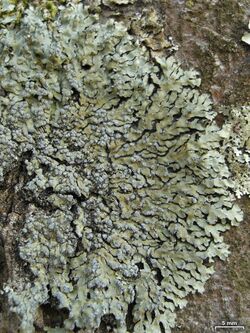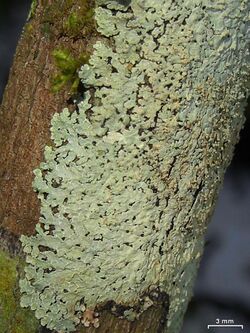Biology:Pyxine
From HandWiki
Short description: Genus of lichens
| Pyxine | |
|---|---|

| |
| Pyxine sorediata | |
| Scientific classification | |
| Domain: | Eukaryota |
| Kingdom: | Fungi |
| Division: | Ascomycota |
| Class: | Lecanoromycetes |
| Order: | Caliciales |
| Family: | Caliciaceae |
| Genus: | Pyxine Fr. (1825) |
| Type species | |
| Pyxine sorediata (Ach.) Mont. (1842)
| |
| Synonyms[1] | |
| |
Pyxine is a genus of foliose lichens in the family Caliciaceae.[2] The genus has a widespread distribution in tropical regions.[3]
The presence or absence of the compound lichexanthone is a character used in classifying Pyxine species; about 20 species contain this compound. This represents the largest group of foliose lichens with the compound.[4]
Species
- Pyxine albovirens (G.Mey.) Aptroot (1987)
- Pyxine astipitata Jungbluth & Marcelli (2011)[5] – Brazil
- Pyxine astridiana Kalb (1987)[6] – neotropical
- Pyxine australiensis Kalb (1994)[7] – Asia; Australia
- Pyxine berteriana (Fée) Imshaug (1957) – pantropical
- Pyxine boonpragobiana Kalb & Mongk. (2012)[8] – Thailand
- Pyxine coccifera (Fée) Nyl. (1858)
- Pyxine cocoes (Sw.) Nyl. (1857)
- Pyxine cognata Stirt. (1879) - pantropical
- Pyxine consocians Vain. (1913)
- Pyxine convexior (Müll.Arg.) Swinscow & Krog (1975)
- Pyxine copelandii Vain. (1913)
- Pyxine cylindrica Kashiw. (1977)[9] – Papua New Guinea
- Pyxine dactyloschmidtii Kalb & Mongkols. (2012)
- Pyxine daedalea Krog & R.Sant. (1986)[10] – Costa Rica
- Pyxine desudans Kalb (1994)[7] – Australia
- Pyxine elixii Kalb (1994)[7] – Australia
- Pyxine endochrysina Nyl. (1890)
- Pyxine endocrocea Kalb (1987)[6]
- Pyxine eschweileri (Tuck.) Vain. (1890)
- Pyxine exoalbida Jungbluth & Marcelli (2011)[5] – Brazil
- Pyxine fallax Kalb (2004)[11]
- Pyxine farinosa Kashiw. (1977)[9] – Papua New Guinea
- Pyxine flavicans M.X.Yang & Li S.Wang (2019)
- Pyxine glaucovirescens (Nyl.) Aptroot (1988)
- Pyxine hengduanensis M.X.Yang & Li S. Wang (2019)
- Pyxine jolyana Jungbluth, Kalb & Marcelli (2011)[12] – Brazil
- Pyxine katendei Swinscow & Krog (1975) – Africa
- Pyxine keralensis D.D.Awasthi (1982)[13] – India
- Pyxine lilacina Swinscow & Krog (1975) – Africa
- Pyxine lyei Swinscow & Krog (1975) – Africa
- Pyxine mantiqueirensis Marcelli & Jungbluth (2011)[5] – Brazil
- Pyxine mexicana Kalb (2002)
- Pyxine minuta Vain. (1890)
- Pyxine nana Kalb (1987) – neotropical
- Pyxine nubila Moberg (1980)[14]
- Pyxine petricola Nyl. (1876) – pantropical
- Pyxine plumea Kalb (1994)[7] – Australia
- Pyxine profallax Kalb (2009)[15]
- Pyxine pseudokeralensis Kalb, Mongk. & Buaruang (2012)
- Pyxine papuana Kashiw. (1977)[9] – Papua New Guinea
- Pyxine punensis Nayaka & Upreti (2013) – India
- Pyxine pungens Zahlbr. (1928)
- Pyxine pustulata Aptroot & Jungbluth (2014)[4] – Brazil
- Pyxine pyxinoides (Müll. Arg.) Kalb (1987) – neotropical
- Pyxine retirugella Nyl. (1859)
- Pyxine rugulosa Stirt. (1898)
- Pyxine schmidtii Vain. (1907)
- Pyxine simulans Kalb (1987) - pantropical
- Pyxine sorediata (Ach.) Mont. (1845)
- Pyxine subcinerea Stirt. (1898) – pantropical
- Pyxine subcoralligera Kalb, Mongkols. & Boonpr. (2012)[8]
- Pyxine yercaudensis Nayaka & Upreti (2013)[16] – India
- Pyxine yunnanensis M.X.Yang & Li S.Wang (2019)[17] – China
References
- ↑ "Synonymy: Pyxine Fr.". Species Fungorum. CAB International. http://www.speciesfungorum.org/Names/SynSpecies.asp?RecordID=4629. Retrieved 2014-10-05.
- ↑ Wijayawardene, Nalin; Hyde, Kevin; Al-Ani, LKT; Dolatabadi, S; Stadler, Marc; Haelewaters, Danny et al. (2020). "Outline of Fungi and fungus-like taxa". Mycosphere 11: 1060–1456. doi:10.5943/mycosphere/11/1/8.
- ↑ Dictionary of the Fungi (10th ed.). Wallingford, UK: CAB International. 2008. p. 587. ISBN 978-0-85199-826-8.
- ↑ 4.0 4.1 Aptroot, André; Jungbluth, Patrícia; Cáceres, Marcela E.S. (2014). "A world key to the species of Pyxine with lichexanthone, with a new species from Brazil". The Lichenologist 46 (5): 669–672. doi:10.1017/s0024282914000231.
- ↑ 5.0 5.1 5.2 Jungbluth, Patrícia; Marcelli, Marcelo Pinto (2011). "The Pyxine pungens complex in São Paulo State, Brazil". The Bryologist 114 (1): 166–177. doi:10.1639/0007-2745-114.1.166.
- ↑ 6.0 6.1 Kalb, K. (1987). "Brasilianische Flechten. 1. Die Gattung Pyxine" (in de). Bibliotheca Lichenologica 24: 1–89.
- ↑ 7.0 7.1 7.2 7.3 Kalb, K. (1994). "Pyxine species from Australia". Herzogia 10: 61–69. doi:10.1127/herzogia/10/1994/61.
- ↑ 8.0 8.1 Mongkolsuk, Pachara; Meesim, Sanya; Poengsungnoen, Vasun; Kalb, Klaus (2012). "The lichen family Physciaceae in Thailand—I. The genus Pyxine". Phytotaxa 59 (1): 32–54. doi:10.11646/phytotaxa.59.1.2.
- ↑ 9.0 9.1 9.2 Kashiwadani, H. (1977). "The genus Pyxine (lichens) in Papua New Guinea". Bulletin of the National Science Museum Tokyo 3: 63–70.
- ↑ Moberg, R. (1986). "Lichenes selecti exsiccati upsaliensis, Fasc. 1 (Nos 1-25)". Thunbergia 2: 1–10.
- ↑ Kalb, K. (2004). "New or otherwise interesting lichens. II". Bibliotheca Lichenologica 88: 301–329.
- ↑ Jungbluth, P.; Marcelli, P.M.; Kalb, K. (2011). "A new species and a new record of Pyxine (Physciaceae) with norstictic acid from São Paulo State, Brazil". Mycotaxon 115: 435–442. doi:10.5248/115.435.
- ↑ Awasthi, D.D. (1980). "Pyxine in India". Phytomorphology 30: 359–379.
- ↑ Moberg, R. (1980). "Studies on Physciaceae (Lichens) 1. A new species of Pyxine". Norwegian Journal of Botany 27 (3): 189–191.
- ↑ Kalb, K.; Archer, A.W.; Sutjaritturakan, J.; Boonpragob, K. (2009). "New or otherwise interesting lichens V". Bibliotheca Lichenologica 99: 225–246.
- ↑ Nayaka, Sanjeeva; Upreti, Dalip K.; Ponmurugan, Ponnusamy; Ayyappadasan, Ganesan (2013). "Two new species of saxicolous Pyxine with yellow medulla from southern India". The Lichenologist 45 (1): 3–8. doi:10.1017/s0024282912000618.
- ↑ Yang, Mei-Xia; Wang, Xin-Yu; Liu, Dong; Zhang, Yan-Yun; Li, Li-Juan; Yin, An-Cheng; Scheidegger, Christoph; Wang, Li-Song (2019). "New species and records of Pyxine (Caliciaceae) in China". MycoKeys 45 (45): 93–109. doi:10.3897/mycokeys.45.29374. PMID 30733639.
Wikidata ☰ Q7263966 entry
 |


